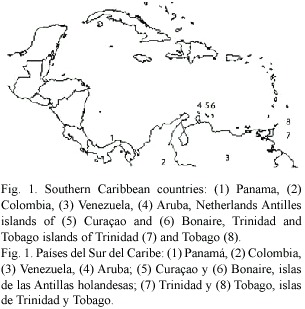Revista de Biología Tropical
versión On-line ISSN 0034-7744versión impresa ISSN 0034-7744
Rev. biol. trop vol.54 supl.3 San José dic. 2006
Isopods (Isopoda: Aegidae, Cymothoidae, Gnathiidae) associated with Venezuelan marine fishes (Elasmobranchii, Actinopterygii)
Lucy Bunkley-Williams,1 Ernest H. Williams, Jr.2 & Abul K.M. Bashirullah3
1 Caribbean Aquatic Animal Health Project, Department of Biology, University of Puerto Rico, P.O. Box 9012, Mayagüez, PR 00861, USA; lwilliams@uprm.edu
2 Department of Marine Sciences, University of Puerto Rico, P.O. Box 908, Lajas, Puerto Rico 00667, USA; ewilliams@uprm.edu
3 Instituto Oceanografico de Venezuela, Universidad de Oriente, Cumaná, Venezuela.
Author for Correspondence: LBW, address as above. Telephone: 1 (787) 832-4040 x 3900 or 265-3837 (Administrative Office), x 3936, 3937 (Research Labs), x 3929 (Office); Fax: 1-787-834-3673; lwilliams@uprm.edu
Received 01-VI-2006. Corrected 02-X-2006. Accepted 13-X-2006.
Abstract: The parasitic isopod fauna of fishes in the southern Caribbean is poorly known. In examinations of 12 639 specimens of 187 species of Venezuelan fishes, the authors found 10 species in three families of isopods (Gnathiids, Gnathia spp. from Diplectrum radiale *, Heteropriacanthus cruentatus *, Orthopristis ruber * and Trachinotus carolinus *; two aegids, Rocinela signata from Dasyatis guttata *, H. cruentatus *, Haemulon aurolineatum *, H. steindachneri * and O. ruber ; and Rocinela sp. from Epinephelus flavolimbatus *; five cymothoids: Anilocra haemuli from Haemulon boschmae *, H. flavolineatum * and H. steindachneri *; Anilocra cf haemuli from Heteropriacanthus cruentatus *; Haemulon bonariense*, O. ruber*, Cymothoa excisa in H. cruentatus *; Cymothoa oestrum in Chloroscombrus chrysurus, H. cruentatus* and Priacanthus arenatus ; Cymothoa sp. in O. ruber; Livoneca sp. from H. cruentatus *; and Nerocila fluviatilis from H. cruentatus * and P. arenatus *). The Rocinela sp. and A. cf haemuli in the southern Caribbean could represent new species. The abundance of A. cf haemuli appears to have drastically reduced from 1994 to 1999 in the Gulf of Cariaco. The Cymothoa sp. represents an undescribed species that is apparently host specific to O. ruber . It does not occur in the Gulf of Cariaco, but is relatively abundant on the Caribbean coast of Sucre State, Venezuela. The Livoneca sp. is an undescribed species host specific to Diapterus rhombeus, Cymothoa excisa and C. oestrum were thought to have distinct host preferences, but both infected the Heteropriacanthus cruentatus in the present study.Gnathia spp. are reported from Venezuelan waters for the first time. Twenty new host records* are noted. The fish-associated isopod fauna is much more extensive and important than has previously been suspected. Rev. Biol. Trop. 54 (Suppl. 3): 175-188. Epub 2007 Jan. 15.
Key words: fish-parasitic isopods, Venezuela, new species, new host, new locality records.
Isopods associate with many species of commercially important fishes around the world and cause significant economic losses to fisheries by killing, stunting, or damaging these fishes. They can also kill or impair immature fishes so that they do not survive. At least one species often and quite painfully bites human swimmers and divers in the Caribbean: sometimes in alarming mass attacks. However, folklore endows these isopods with positive qualities. The presence of isopods on Caribbean fishes is supposed to indicate that the host is free of ciguatera (fish poisoning) toxins [not tested] and dried isopods are used as folk medicines around the world. Despite their importance, isopods associated with fishes are relatively poorly studied or even surveyed in many parts of the world (Williams and Bunkley-Williams 1996, Bunkley-Williams and Williams 1998).
Few reports of fish-associated isopods have been made in the southern Caribbean (Fig. 1): only 17 species of isopods have been recorded from 39 species of fishes (Table 1). The authors use the term "fish-associated" because some aegids and corallanids on fishes may be minipredators instead of parasites, and few of them are known well enough to be certain. Bashirullah (1991) examined the attachment positions of Anilocra laticauda H. Milne Edwards in Venezuela. Delaney (1989) noted Alcirona spp., isopods that sometimes associate with fishes, from Colombia. Garzon-Ferreira (1990) noted an isopod, which often associates with fishes, attacking humans in Colombia.
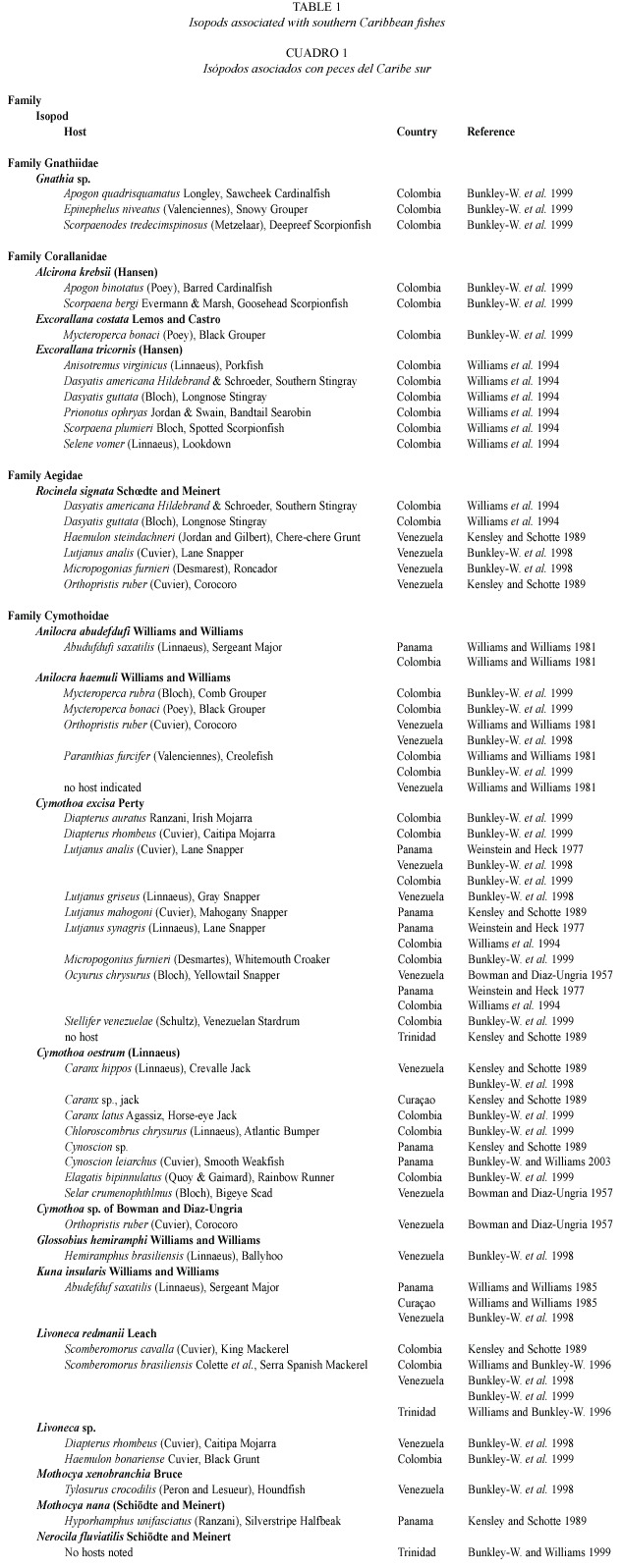
A collection of isopods taken from marine fishes in Venezuela (Fig. 2), July 1999, is reported below including four undescribed species, a new geographic record for Venezuela, and 20 new host records. Kensley and Schotte (1989) provided keys, diagnostic characters, and biological information about all of the species the authors discuss.
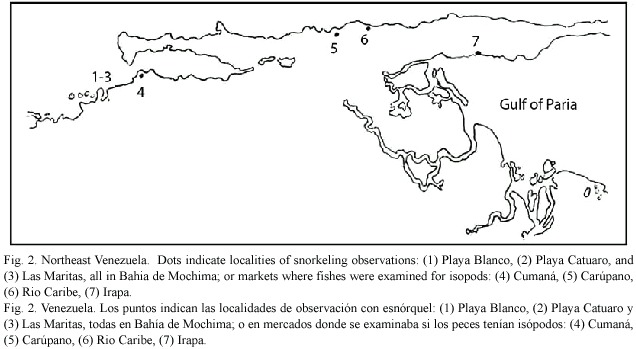
Materials and methods
Fishes were obtained from fish markets after having been captured by trawl, traps, trammel nets, spearing, and hook and line. The external surfaces, mouth and gill chambers of each fish were examined grossly without the aid of magnification at the markets (Fig. 3). Some specimens were purchased and transported to the laboratory for microscopic examination. Gnathiid isopods were only found on those hosts examined microscopically. Isopods were preserved in 70% ethanol in individual vials for each host specimen. All isopod specimens were deposited in the U.S. National Parasite Collection (USNPC). The authors were familiar with all of the isopod and fish host species reported. The keys and diagnostic characters provided in Kensley and Schotte (1989) can be used to identify all of these isopods. The authors carried a copy of Cervigón et al. (1993) in the field with them during examinations, which was useful in identifying some fishes on site (Appendix 1). Not all fish hosts were preserved. Tumors and other parasites collected from some of these hosts will be reported elsewhere. Using snorkeling equipment, the authors observed external isopods at three localities in Mochina National Park (Table 2, Fig. 2). This article was submitted for publication in the 29th AMLC Proceedings in 1999 (Anonymous 2000) immediately after the study was conducted, but the manuscript was misplaced at some point in the process. It was updated and resubmitted in 2005.
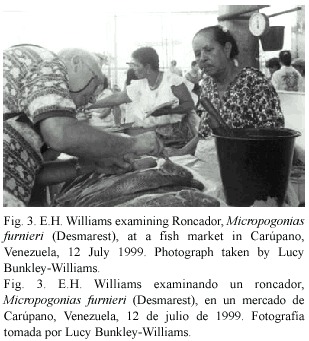
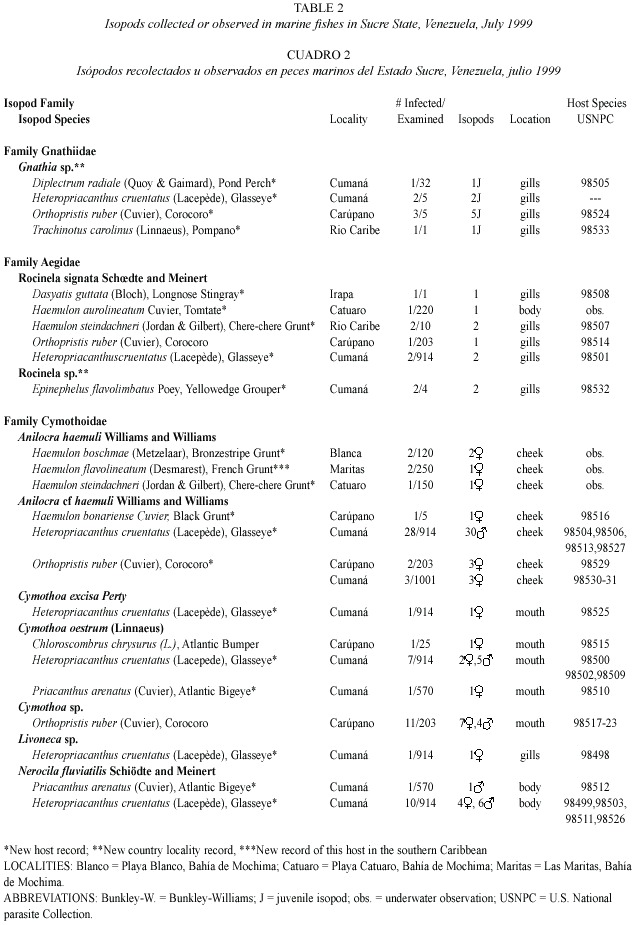
Results and discussion
Eighty-seven isopods representing 10 species (or more because of the unknown number of gnathid species) were collected from 12 639 specimens representing 187 species of fishes (Table 2, Appendix 1). The use of fish markets for obtaining hosts certainly limited the diversity and abundance of parasites collected. However, it did focus our efforts on the more economically important fishes in the region. Length of fish storage; use of ice, refrigeration or freezing; rough and frequent handling; and rinsing in salt or freshwater caused the loss or diminished the numbers of available parasites.
Anilocra cf haemuli Williams and Williams (Fig. 4): Anilocra haemuli infects a variety of grunts (Haemulidae) and groupers (Serranidae) throughout the West Indies (Williams and Williams 1981). One form in the southern Caribbean infects different fish species than those individuals found further north and also differs by occurring on off-reef habitats (Bunkley-Williams et al. 2000). This form also possesses some minor morphological differences from A. haemuli. The authors are in the process of genetically evaluating this and other forms in this possible species complex (Bunkley-Williams and Williams, unpubl. data). This southern form could represent a distinct species (Fig. 4). This isopod was called Anilocra laticauda H. Milne Edwards by Bashirulla (1991), a name the present authors declared nomen dubium in 1981.
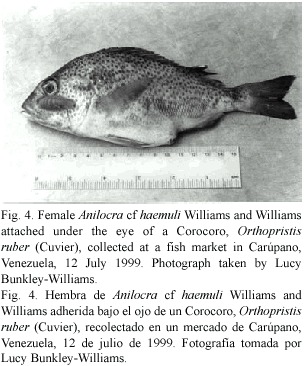
The authors found this isopod on only three of 1001 Orthopristis ruber examined from the Gulf of Cariaco (Table 2). This scarcity was not merely the result of losses due to handling because the typical and obvious external wounds caused by this isopod were also absent. Three years prior to this study this isopod was abundant in the Gulf of Cariaco and parasitized 3-6% of the Orthopristis ruber (Bashirulla, unpubl. data). Bunkley-Williams et al. (1998) found five of 30 (16.7%) O. ruber examined around Cumaná prior to 1992 infected with this isopod. The authors were unable to determine the cause for the reduction in prevalence of this isopod in the Gulf. Fishermen told us that this isopod also occurs on the Chere-chere Grunt, Haemulon steindachneri (Jordan and Gilbert), but the authors were unable to find specimens of this isopod on this fish.
Heteropriacanthus cruentatus appear to be acting as intermediate hosts for this isopod. The juveniles or males of this isopods occurred abundantly on the body of this host in the Gulf of Cariaco, but no adult females were found on this host.
Cymothoa excisa Perty: This is an important isopod due to its preference for members of the commercially important snapper family (Lutjanidae).This mouth-dwelling isopod stunts or reduces growth in infected snappers thus causing significant economic losses in snapper fisheries (Bunkley-Williams et al. 1998, 1999, Kensley and Schotte 1989, Weinstein and Heck 1977).
It is similar to C. oestrum in size, geographic range, and location in the host, but that isopod prefers jacks. Cymothoa excisa and C. oestrum were thought to have distinct host preferences, but both infected the Glasseye in the present study. However, both infections were very rare (Table 2) and may have represented little more than accidental infections. The Glasseye appears to be so abundant that it was available as a host for 8 of the 10 species of isopods we collected.
Cymothoa oestrum (Linnaeus): This isopod typically infects jacks throughout the tropical and subtropical western Atlantic (Williams and Bunkley-Williams 1996, Bunkley-Williams et al. 1998). The authors examined 235 specimens of seven species of jacks, but only found this isopod once (Table 2). This unusual scarcity may be due to losses during the handling of hosts. Williams and Bunkley-Williams (1994) described its early juvenile stages. Bunkley-Williams and Williams (2003) recently documented the plasticity of the morphology of this isopod as it becomes larger. Thatcher et al. (2003) redescribed this species on the basis of one specimen from Brazil without comparison with the original type material. This isopod causes some stunting and losses of jacks, which are becoming more commercially important in the Caribbean region as other fish species become over exploited.
Cymothoa sp. of Bowman and Diaz-Ungria (Figs. 5-6): Bowman and Diaz-Ungria (1957) found a female and male pair of this isopod in Orthopristis ruber from "Paria (Estado Sucre)" Venezuela. This apparently refered to the Gulf of Paria, since there is no town in the Sucre State by that name. They suggested that this isopod represented a new species, but declined to describe it with only two specimens. The authors attempted to find additional specimens of this isopod in the Gulf of Cariaco in 1992 (Bunkley-Williams et al. 1998), but it apparently does not occur there (Table 2; Bashirulla, unpubl. data). It was relatively abundant in the O. ruber on the Caribbean coast of Sucre (Table 2).
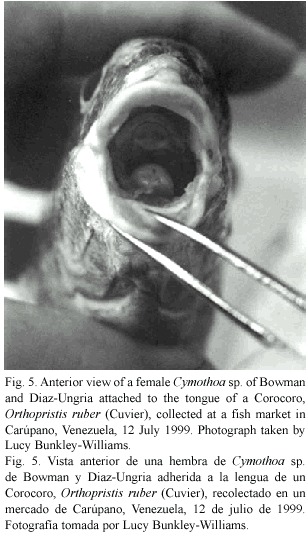
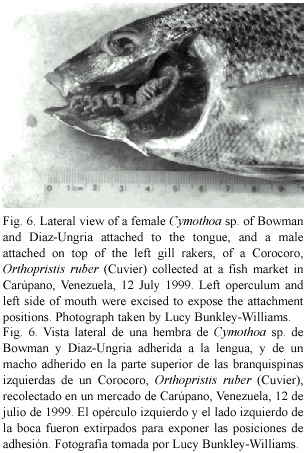
The female isopod occurs on the tongue of the host (Figs. 5, 6) and the male on the gill rakers of one gill chamber (Fig. 6), which is typical for many species of the genus. It occupies almost the entire oral cavity (Fig. 5) and probably modifies the diet of the host since the size of items swallowed must be less. Kimmel and Arneson (1978) studied the food habits of jacks infected with C. oestrum in Puerto Rico and found that the volume of the food was the same as in uninfected jacks, but the sizes and types of food items differed.
The externally-attaching isopods, Anilocra abudefdufi Williams and Williams and A. acanthuri Williams and Williams, infect the Sergeant Major, Abudefduf saxatilis (Linnaeus) and the Doctorfish, Acanthurus chirurgus (Bloch), respectively. These hosts are more likely to be infected with gill-dwelling isopods Kuna insularis Williams and Williams and Agarna cumulus (Haller), respectively (Williams and Williams 1981, 1985). The authors have not been able to determine the basis of this interesting interspecific cooperation. In the case of the externally-attaching Anilocra cf haemuli and the mouth-dwelling Cymothoa sp. both infecting O. ruber, the authors have not found both species on the same host specimen. Interspecific antagonism could be occurring; however, more hosts must be examined to determine the relationship between these two isopod species.
This isopod is apparently host specific to O. ruber and represents an undescribed species. The authors are preparing a description of this isopod.
Gnathia spp.: These isopods were found on four new hosts (Table 2), and are reported for the first time in Venezuela. Müller (1988) noted Gnathia spp. in the southern Caribbean, but was concerned only with the adult males, which do not occur on fishes. They are very numerous and ubiquitous throughout the Caribbean. Their blood feeding takes an enormous amount of energy and resources away from coral-reef fishes and they have caused mortalities in aquaculture fishes (Bunkley-Williams and Williams 1998).
Livoneca sp. of Bunkley-Williams et al.: This isopod is found in the gill chambers of the Caitipa mojarra, Diapterus rhombeus (Cuvier), throughout the southern Caribbean (Bunkley-Williams et al. 1998). A record in Haemulon bonariense could have represented an accidental infection (Bunkley-Williams et al. 2000), as is probably the case with the present record in one of 914 Heteropriacanthus cruentatus (Table 2). Its occasional accidental parasitism is interesting, but it seems largely host specific to the Caitipa mojarra. The authors are preparing a description of this isopod. It causes extreme damage to the opercular flap of the host, but since this is not a commercially important host, the economic damage is slight.
Nerocila fluviatilis Schioedte and Meinert: The authors found this isopod on fishes in Trinidad and Tobago (Bunkley-Williams and Williams 1999, unpubl. data), which represented a new locality record. In the present study, the authors only found this isopod on Heteropriacanthus cruentatus and rarely on Priacanthus arenatus and only in the Gulf of Cariaco (Table 2).This is a new locality and host record. This isopod can cause considerable damage to its host and occurs on a great variety of hosts including some of commercial importance. It was previously thought to be restricted to the eastern coast of South America. The authors records in Venezuela and Trinidad and Tobago, extend its range into the northern coast of South America and the Caribbean Sea, although it may not extend much further since the authors did not find it in Bonaire and Curaçao (Bunkley-Williams and Williams 1981, unpubl. data), Colombia (Williams et al. 1994, Bunkley-Williams et al. 1999) or Panama (Williams and Bunkley-Williams 1985), or northern Tobago (Williams, unpubl. data).
Rocinela signata Schdte and Meinert: The authors found this isopod on five new fish hosts. It occurs throughout the Caribbean on a great variety of fishes. This isopod is particularly abundant in the gill chambers of larger commercially important hosts (e.g., hogfish, snappers, groupers). Thus it is responsible for reducing the growth rate of many of these important fishes. This is also the only fish-associated isopod that treats humans like a routine food source. The bite of this isopod is painful, bloody, and particularly terrifying in mass attacks. The authors gave this isopod the common name of "Monogram Isopod" because of the inverted W-shaped mark on its pleotelson (tail) (Garzon-Ferreira 1990, Bunkley-Williams and Williams 1998, unpubl. data).
Rocinela sp.: These specimens appear to represent a new species of Rocinela. They do not conform to any species of this genus known from the Caribbean. Only R. signata has been noted to associate with fishes in the Atlantic. The new species may represent another fish- associated isopod.
Distributions: Too little is known about isopods associated with fishes in the southern Caribbean to adequately discuss their zoogeography. One large-scale division of the Caribbean into continental and insular regions, first noted in fish distributions by Erdman (1963) and later refined by Robins (1971); however, seems to also occur in some fish-parasitic isopods of the southern Caribbean. Anilocra abudefdufi, Cymothoa excisa, Cymothoa sp., Kuna insularis, Livoneca sp., and Nerocila fluviatilis appear to have a continental distribution in the Caribbean. Alcirona krebsii, Anilocra haemuli, Excorallana tricornis, Cymothoa oestrum, Glossobius hemiramphi, Livoneca redmanii, Mothocya nana, M. xenobranchia, and Rocinela signata occur in both Caribbean continental and insular areas (Bowman and Diaz-Ungria 1957, Weinstein and Heck 1977, Williams and Bunkley-Williams 1981, 1985, 1996, Delaney 1989, Kensley and Schotte 1989, Bashirullah 1991, Williams et al. 1994, Bunkley-Williams et al. 1998, 1999, Bunkley-Williams and Williams 1999, 2003 unpubl. data).
Acknowledgments
The authors thank J. Ralph Lichtenfels, U. S. National Parasite Collection, Biosystematic Parasitology Laboratory, for depositing the specimens and providing museum numbers. Partial support was provided by Sportfish Restoration Funds, Wallop-Braux Project F-28-13.
Resumen
Se conoce muy poco acerca de la fauna de isópodos parásitos de peces en el Caribe Sur. Tras examinar 12 639 especímenes de 187 especies de peces de Venezuela, los autores encontraron 10 especies de isópodos distribuidos en tres familias. Los asteriscos indican nuevos registros (Gnátidos, Gnathia spp. en Diplectrum radiale*, Heteropriacanthus cruentatus*; Orthopristis ruber* y Trachinotus carolinus*; dos aégidos, Rocinela signata en Dasyatis guttata*, H. cruentatus*, Haemulon aurolineatum*, H. steindachneri * y O. ruber ; y Rocinela sp. en Epinephelus flavolimbatus*; cinco cimotoidos: Anilocra haemuli en Haemulon boschmae*, H. flavolineatum* y H.steindachneri*; Anilocra cf haemuli en Heteropriacanthus cruentatus*; Haemulon bonariense*, O. ruber*; Cymothoa excise in H. cruentatus*; Cymothoa oestrum en Chloroscombrus chrysurus, H. cruentatus* y Priacanthus arenatus; Cymothoa sp. en O. ruber; Livoneca sp. en H. cruentatus*; y Nerocila fluviatilis en H. cruentatus* y P. arenatus*). Las especies Rocinela sp.y A.cf haemuli en el Caribe sur podrían representar especies distintas. La abundancia de A. cf haemuli en el Golfo de Coriaco parece haberse reducido drásticamente entre 1994 a 1999. Cymothoa sp.es una especie no descrita que aparentemente parasita específicamente a O. ruber. No se le encuentra en el Golfo de Cariaco, pero es relativamente abundante en la costa Caribe del Estado de Sucre, Venezuela. Livoneca sp. (especie sin describir) parasita específicamente a Diapterus rhombeus. Anteriormente se pensaba que Cymothoa excisa y C. oestrum tenían distintas preferencias de hospedero, pero ambas infectan a Heteropriacanthus cruentatus. Gnathia spp. Son además primer registro en aguas venezolanas. Se informan en total 20 nuevos registros. La fauna de isópodos asociados a peces es mucho más extensa e importante de lo que se sospechaba.
Palabras clave: isópodos parásitos de peces, Venezuela, nuevas especies, nuevos hospederos, nuevos registros de localidad.
References
Anonymous. 2000. Proceedings of the 29th Scientific Meeting, Association of Marine Laboratories of the Caribbean, Cumaná, Venezuela. Rev. Biol. Trop. 48(Suppl. 1): 1-279. [ Links ]
Bashirullah, A. K. M. 1991. Occurrence and site specificity of an isopod Anilocra laticauda H. Milne Edwards, 1840 (Isopoda, Cymothoidae) parasitic on the grunt, Orthopristis ruber (Cuvier) in eastern Venezuela. Crustaceana 61: 38-42. [ Links ]
Bowman, T. E. & C. Diaz-Ungria. 1957. Isopodos quimotoideos parasitos de peces de las aguas Venezolanas. Mem. Soc. Cienc. Nat. "La Salle" 17: 112-124. [ Links ]
Bunkley-Williams, L. & E. H. Williams, Jr. 1998. Isopods associated with fishes: A synopsis and corrections. J. Parasit. 84: 893-896. [ Links ]
Bunkley-Williams, L. & E. H. Williams, Jr. 1999. Nerocila benrosei n. sp. (Isopoda: Cymothoidae) an external parasite of hogfishes from the northern Bahamas. J. Parasit. 85: 1036-1040. [ Links ]
Bunkley-Williams, L.& E. H. Williams, Jr. 2003. The identity of the seldom found Caribbean and Gulf of Mexico fish-parasitic isopod, Cymothoa caraibica Bovallius, resolved: A neoteric synonym of C. oestrum (L.). Caribbean J. Sci. 39: 245-248.(Also available on line: http://caribjsci.org/aug03/39_245_248.pdf). [ Links ]
Bunkley-Williams, L., E. H. Williams, Jr., & A. K. M. Bashirulla. 1998. Some isopods associated with Venezuelan fishes. Carib. Mar. Stud. 6: 27-30. [ Links ]
Bunkley-Williams, L., E. H. Williams, Jr. & J. Garzon-Ferreira. 1999. Some isopod and copepod parasites (Crustacea) of Colombian marine fishes. Carib. J. Sci. 35: 311-314. [ Links ]
Cervigón, F., R. Ciprani, W. Fischer, L. Garibaldi, M. Hendrickx, A. J. Lemus, R. Márquez, J. M. Poutiers, G. Robaina & B. Rodríguez. 1993. Field guide to the commercial marine and brackish-water resources of the northern coast of South America. Food and Agriculture Organization of the United Nations, Rome, Italy. 513 p. [ Links ]
Delaney, P. M. 1989. Phylogeny and biogeography of the marine isopod family Corallanidae (Crustacea, Isopoda, Flabellifera).Natural History Museum of Los Angeles County, Contributions in Science 409:1-75. [ Links ]
Erdman, D.S. 1963. Discontinuity in marine fish distribution in the Caribbean. Carib. Agricult. 1: 127-131. [ Links ]
Garzon-Ferreira, J. 1990. An isopod, Rocinela signata (Crustacea: Isopoda: Aegidae), that attacks humans. Bull. Mar. Sci. 46: 813-815. [ Links ]
Kensley, B. & M. Schotte. 1989. Marine isopod crustaceans of the Caribbean. Smithsonian Institution Press, Washington, D.C. 308 p. [ Links ]
Kimmel, J. J. & D. W. Arneson. 1978. The response of two species of jacks, C. latus and C. hippos to the isopod ectoparasite, Cymothoa oestrum. Proc. Assoc. Isl. Mar. Labs. Carib. 14: 27 (abstract). [ Links ]
Müller, H.-G. 1988. The genus Gnathia Leach (Isopoda) from Santa Marta area, northern Colombia, with a review of Gnathiidea from the Caribbean Sea and Gulf of Mexico. Bijdragen Tot de Dierkunde 58:88-104. [ Links ]
Robins, C. R. 1971. Distribution patterns of fishes from coastal and shelf waters of the tropical western Atlantic. Symposium on Investigations and Resources of the Caribbean Sea and Adjacent Regions. Papers on Fisheries Resources, FAO United Nations, Rome, Italy. Pp. 249-255. [ Links ]
Thatcher, V. E., J. de Loyola e Silva, G. F. Jost & J. M. Souza-Conceiçã. 2003. Comparative morphology of Cymothoa spp. (Isopoda, Cymothoidae) from Brazilian fishes, with the description of Cymothoa catarinensis sp. nov. and redescriptions of C. excisa Perty and C. oestrum (Linnaeus).. Rev. Bras. Zool. 20: 541-552. [ Links ]
Weinstein, M. P. & K. L. Heck. 1977. Biology and host-parasite relationships of Cymothoa excisa (Isopoda, Cymothoidae) with three species of snappers (Lutjanidae) on the Caribbean coast of Panama. Fish. Bull. 75: 875-877. [ Links ]
Williams, E. H., Jr. & L. Bunkley-Williams. 1994. Four cases of unusual crustacean-fish associations and comments on parasitic processes. J. Aquatic Animal Health 6: 202-208. [ Links ]
Williams, E. H., Jr. & L. Bunkley-Williams. 1996. Parasites of off shore, big game sport fishes of Puerto Rico and the Western North Atlantic. Puerto Rico Department of Natural and Environmental Resources, San Juan, Puerto Rico, and Department of Biology, University of Puerto Rico, Mayagüez, Puerto Rico. 384 p. [ Links ]
Williams, E. H., Jr., L. Bunkley-Williams & C. J. Sanner. 1994. New host and locality records for copepod and isopod parasites of Colombian marine fishes. J. Aquatic Animal Health 6: 362-364. [ Links ]
Williams, E. H., Jr. & L. B. Williams. 1985. Cuna insularis n. gen. and n. sp. (Isopoda: Cymothoidae) from the gill chamber of the sergeant major, Abedufduf saxatilis (Linnaeus), (Osteichthyes) in the West Indies. J. Parasit. 71: 209-214. [ Links ]
Williams, L. B. & E. H. Williams, Jr. 1981. Nine new species of Anilocra (Crustacea: Isopoda: Cymothoidae) external parasites of West Indian coral reef fishes. Proc. Biol. Soc. Wash. 94: 1005-1047. [ Links ]
Host fishes examined for isopod parasites
Anexo 1
Peces hospederos examinados para detección de isópodos parásitos
Class, Order, Family Scientific-common name, scientific name, author, common name, and number of specimens examined are noted in phylogenetic order. Number examined in fish markets for macroparasites on the body, fins, gills, and mouth are in (parenthesis), number examined underwater for macroparasites on the body and fins in [brackets], and number examined for total metazoan parasites in detail in the laboratory in {curly brackets}. Numbers do not necessarily represent all of the specimens available, but the number that the authors had time to examine. Most of the fish species were identified in the field without benefit of detailed laboratory examinations. The authors feel confident in our identifications, but in the process of quickly examining large numbers of fish, a few specimens of similar species may have been occasionally confused. Fish specimens infected with isopods were individually and carefully identified. All fish specimens were adults, but only those with isopod parasites were measured. Cervigón et al. (1993) was used as a field guide.
Class Elasmobranchii -sharks and rays, Order Carcharhiniformes -ground sharks, Family Carcharhinidae -requiem sharks, Blacknose Shark,Carcharhinus acronotus (Poey) (6); Bullshark, C. leucas (Müller & Henle) (3); Blacktip Shark, C. limbatus (Müller & Henle) (22); Dusky Shark, C. obscurus (Leseuer) (6); Lemon Shark, Negaprion brevirostris (Poey) (1); Brazilian Sharpnose Shark, Rhizoprionodon lalandii (Müller & Henle) (35); Caribbean Sharpnose Shark, R. porosus (Poey) (50); Family Triakidae -houndsharks, Dusky Smooth-hound, Mustelus canis (Mitchill) (25);Family Sphyrnidae -hammerhead etc. sharks, Bonnethead, Sphyrna tiburo (L.) (30); Order Squaliformes -dogfish etc.sharks, Family Squalidae -dogfish sharks, Cuban Dogfish, Squalus cubensis Rivero (100); Order Rajiformes -skates and rays, Family Dasyatidae -stingrays, Southern Stingray, Dasyatis americana Hildebrand & Schroeder (35); Sharpsnout Stingray, D. geijkesi Boeseman (2); Class Actinopterygii -ray-finned fishes, Order Elopiformes -tarpons and tenpounders, Family Megalopidae -tarpons, Tarpon, Megalops atlanticus Valenciennes (16); Order Abuliformes -bonefishes, Family Albulidae - bonefishes, Threadfin Bonefish, Albula nemoptera (Fowler) (2); Order Clupeiformes -herrings etc., Family Clupeidae -herrings etc., Atlantic Thread Herring, Opisthonema oglinum (Lesueur) (300), Round Sardinella, Sardinella aurita Valenciennes (100), Brazilian Sardinella, S. janeiro (Egenmann)(100); Family Engraulididae -anchovies, Broadband Anchovy, Anchoviella lepidentostole (Fowler) (100); Order Siluriformes -catfishes, Family Ariidae -sea catfishes, Couma Sea Catfish, Hexanematichthys couma (Valenciennes) (6); Gillbacker Sea Catfish, H. parkeri (Trail) (25); Passany Sea Catfish, H. passany (Valenciennes) (32); Thomas Sea Catfish, Notarius grandicassis (Valenciennes)(10); Coco Sea Catfish, Bagre bagre (Linnaeus) (20), Gafftopsail Sea Catfish, Bagre marinus (Mitchell) (100); Family Auchenipteridae -driftwood catfishes, Cocosoda Catfish, Pseudauchenipterus nodosus (Bloch) (10); Family Pimelodidae -long- whiskered catfishes, Kumakuma, Brachyplatystoma filamentosum (Lichtenstein) (5); Highwaterman Catfish, Hypophthalmus edentatus Spix & Agassiz (13); Order Ophidiiformes -cusk eels, Family Ophidiidae - cusk-eels, Shortbeard Cusk-eel, Lepophidium brevibarbe (Cuvier)(20); Bank Cusk-el, Ophidion holbrookii (Putnam) (16); Order
Batrachoidiformes -toadfishes, Family Batrachoididae -toadfishes, Bocon Toadfish, Amphichthys cryptocentrus (Valenciennes) (66); Pacuma Toadfish, Batrachoides surinamensis (Bloch & Schneider) (20); Order Beryciformes -sawbellies, Family Holocentridae -squirrelfishes & soldierfishes, Squirrelfish, Holocentrus adscensionis (Osbeck)(6) [35];Blackbar Soldierfish, Myripristis jacobus Cuvier [51]; Order Scorpaeniformes -scorpionfishes & flatheads, Family Sebastidae -rockfishes etc., Blackbelly Rosefish, Helicolenus dactylopterus dactylopterus (Delaroche) (25); Order Perciformes - perch-like fishes, Family Centropomidae - snooks, Fat Snook, Centropomus parallelus Poey (5); Tarpon Snook, C. pectinatus Poey (6); Snook, C. undecimalis (Bloch) (15); Family Serranidae -sea basses etc., Pound Perch, Diplectrum radiale (Quoy & Gaimard) (65); Coney, Epinephelus fulva (Linnaeus) (25) [36]; Rock Hind, E. adscensionis (Osbeck) (16) {1}; Yellowedge Grouper, E. flavolimbatus Poey (50) {1}; Red Hind, E. guttatus (Linnaeus) (50)[19]; Snowy Grouper, E. niveatus (Valenciennes) (10); Venezuelan Grouper, Mycteroperca cidi Cervigón (60); Yellowmouth Grouper, M. interstitialis (Poey) (20); Mottled Grouper, M. rubra (Bloch) (20); Yellowfin Grouper, M. venenosa (Linnaeus) (10); Family Priacanthidae -bigeyes, Glasseye, Heteropriacanthus cruentatus (Lacepède) (300) [37] {4}; Atlantic Bigeye, Priacanthus arenatus Cuvier (200) {2}; Family Malacanthidae - tilefishes, Atlantic Goldeye Tilefish, Caulolatilus chrysops (Valenciennes) (16); Family Pomatomidae -bluefishes, Bluefish, Pomatomus saltatrix (Linnaeus) (7); Family Rachycentridae -cobias, Cobia, Rachycentron canadum (Linnaeus) (3); Family Carangidae - jacks & pompanos, Yellow Jack, Carangoides bartholomaei (Cuvier) (35); Bar Jack, C. ruber (Bloch) (200); Blue Runner, Caranx crysos (Mitchill) (157) {1}; Crevalle Jack, C. hippos (Linnaeus)(45); Horse-eye Jack, C. latus Agassiz (35); Atlantic Bumper, Chloroscombrus chrysurus (Linnaeus)(100){1}; Mackerel Scad, Decapterus macarellus (Cuvier) (120); Round Scad, D. punctatus (Cuvier)(30); Roughear Scad, D. tabl Berry (25); Rainbow Runner, Elagatis bipinnulata (Quoy & Gaimard) (5); Bluntnose Jack, Hemicaranx amblyrhynchus (Cuvier) (4); Maracaibo Leatherjacket, Oligoplites palometa (Cuvier) (50); Castin Leatherjacket, O. saliens (Bloch) (40); Atlantic Leatherjack, O. saurus (Bloch & Schneider) (100); Bigeye Scad, Selar crumenophthalmus (Bloch) (250); Atlantic Moonfish, Selene setapinnis (Mitchill) (10); Lookdown, S. vomer (Linnaeus) (30); Greater Amberjack, Seriola dumerili (Risso) (1); Pompano, Trachinotus carolinus (Linnaeus)(25){1};Cayenne Pompano, T. cayennensis Cuvier (10); Permit, T. falcatus (Linnaeus) (25); Palometa, T. goodei Jordan & Everman (6); Rough Scad, Trachurus lathami Nichols (220); Family Coryphaenidae - dolphinfishes, Dolphinfish, Coryphaena hippurus Linnaeus (16); Family Lutjanidae -snap- pers, Mutton Snapper, Lutjanus analis (Cuvier) (26);Schoolmaster Snapper, L. apodus (Walbaum) (120); Blackfin Snapper, L. buccanella (Cuvier)(6); Cubera Snapper, L. cyanopterus (Cuvier) (10); Gray Snapper, L. griseus Linnaeus) (275); Dog Snapper, L. jocu (Bloch & Schneider) (32); Mahogany Snapper, L. mahogoni (Cuvier) (56); Southern Red Snapper, L. purpureus Poey (270); Lane Snapper, L. synagris (Linnaeus) (27); Silk Snapper, L. vivanus (Cuvier) (51); Yellowtail Snapper, Ocyurus chrysurus (Bloch) (160); Wenchman, Pristipomoides aquilonaris (Goode & Bean) (12); Cardinal Snapper, P. macrophthalmus (Müller & Troschel) (6); Vermilion Snapper, Rhomboplites aurorubens (Cuvier) (2); Family Lobotidae -tripletails, Atlantic Tripletail, Lobotes surinamensis (Bloch) (2); Family Gerreidae -mojarras, Brazilian Mojarra, Eugerres brasilianus (Cuvier)(55); Striped Mojarra, E. plumieri (Cuvier) (110); Yellowfin Mojarra, Gerres cinereus (Walbaum)(20); Family Haemulonidae -grunts, Black Margate, Anisotremus surinamensis (Bloch) (35); Barred Grunt, Conodon nobilis (Linnaeus)(20); White Margate, Haemulon album Cuvier (15); Tomtate, H. aurolineatum Cuvier [575]; Black Grunt, H. bonariense Cuvier (35) [26] {11}; Bronzestriped Grunt, H. boschmae (Metzelaar) [325]; Caesar Grunt, H. carbonarium Poey [87]; Smallmouth grunt, H. chrysargyreum Günther [260]; French Grunt, H. flavolineatum (Desmarest) (5) [275]; Spanish Grunt, H. macrostomum Günther (3) [6]; Cottonwick Grunt, H. melanurum (Linnaeus) (25) [210]; Sailors Grunt, H. parra (Desmarest) (12); White Grunt, H. plumierii (Lacepède) (23) [16]; Bluestriped Grunt, H. sciurus (Shaw) (20) [36]; Chere-chere Grunt, H. steindachneri (Jordan and Gilbert)(50)[415] {2}; Corocoro Grunt, Orthopristis ruber (Cuvier)(250){9}; Roughneck Grunt, Pomadasys corvinaeformis (Steindachner) (10); Family Inermiidae -bon- netmouths, Boga, Inermia vittata Poey (35); Family Sparidae -porgies, Western Atlantic Seabream, Archosargus rhomboidalis (Linnaeus) (16); Jolthead Porgy, Calamus bajonado (Bloch & Schneider) (35); Saucereye Porgey, C. calamus (Valenciennes) (70); Sheepshead Porgy, C. penna (Valenciennes) (15); Pluma Porgy, C. pennatula Guichenot (80); Family Sciaenidae -drums, Ground Croaker, Bairdiella rhonchus (Cuvier) (25); Striped Croaker, B. sanctaeluciae (Jordan) (10); Acoupa Weakfish, Cynoscion acoupa (Lacepède) (20); Smooth Weakfish, C. leiarchus (Cuvier) (10); Smallscale Weakfish, C. microlepidotus (Cuvier) (25); Tonkin Weakfish, C. similis Randall & Cervigon (30); Green Weakfish, C. virescens (Cuvier) (50); Shorthead Drum, Larimus breviceps (Cuvier) (10); King Weakfish, Macrodon ancylodon (Bloch & Schneider)(120); Gulf King Croaker, Menticirrhus littoralis (Holbrook)(22); Whitemouth Croaker, Micropogonias furnieri (Desmarest) (200); Smalleye Croaker, Nebris microps Cuvier (50); Spotted Croaker, Ophioscion punctatissimus Meek & Hildebrand (1); Sand Drum, Umbrina coroides Cuvier (200); Family Mullidae -goatfishes,Yellow Goatfish, Mulloidichthys martinicus (Cuvier) (25); Spotted Goatfish, Pseudupeneus maculates (Bloch) (12); Family Kyphosidae -sea chubs, Yellow Sea Chub, Kyphosus incisor (Cuvier) (66); Bermuda Sea Chub, K. sectator (Linnaeus) (25); Family Ephippidae -spade- fishes, Atlantic Spadefish, Chaetodipterus faber (Broussonet)(15); Family Chaetodontidae -butterflyfishes, Foureye Butterflyfish, Chaetodon capistratus Linnaeus [41]; Spotfin Butterflyfish, C. ocellatus Bloch [2]; Banded Butterflyfish, C. striatus Linnaeus [9]; Family Pomacanthidae -angelfishes, Rock Beauty, Holacanthus tricolor (Bloch) [16]; Gray Angelfish, Pomacanthus arcuatus (Linnaeus) (10); Family Pomacentridae -damselfishes, Blue Chromis, Chromis cyanea (Poey) [75]; Brown Chromis, C. multilineata (Guichenot) [23]; Family Mugilidae -mullets, White Mullet, Mugil curema Valenciennes (120); Redeye Mullet, M. gaimardianus Desmarest (10); Lebranche Mullet, M. liza Valenciennes (23); Family Sphyraenidae -barracudas, reat Barracuda, Sphyraena barracuda (Walbaum) (40); Guaguanche, S. guachancho Cuvier (15); Family Polynemidae -threadfins, Littlescale Threadfin, Polydactylus oligodon (Günther) (20); Family Labridae -wrasses, Spanish Hogfish, Bodianus rufus (Linnaeus)(7); Hogfish, Lachnolaimus maximus (Walbaum) (3); Family Scaridae -parrotfishes, Blue Parrotfish, Scarus coeruleus (Bloch) (20); Striped Parrotfish, S. iseri (Bloch)(25); Princess Parrotfish, S. taeniopterus Desmarest (5); Queen Parrotfish, S. vetula Bloch & Schneider (30); Redtail Parrotfish, Sparisoma chrysopterum (Bloch & Schneider) (10); Redfin Parrotfish, S. rubripinne (Valenciennes)(200); Stoplight Parrotfish, S. viride (Bonnaterre)(100); Family Acanthuridae -surgeonfishes etc., Ocean Surgeon, Acanthurus bahianus Castelnau [330]; Blue Tang, A. coeruleus Bloch & Schneider [125]; Doctorfish, A. chirurgus (Bloch) [38]; Family Trichiuridae -cutlassfishes, Longhead Hairtail, Trichiurus lepturus Linnaeus (257){5}; Family Scombridae -mackerels, Wahoo, Acanthocybium solandri (Cuvier)(26); Bullet Tuna, Auxis rochei (Risso)(25); Frigate Tuna, A. thazard thazard (Lacepède) (50); Little Tuny, Euthynnus alletteratus (Rafinesque)(60); Skipjack Tuna, Katsuwonus pelamis (Linnaeus) (100); Atlantic Bonito, Sarda sarda (Bloch)(30); Chub Mackerel, Scomber japonicus Houttuyn (100); Serra Spanish Mackerel, Scomberomorus brasiliensis Collette, Russo, and Zavala-Camin (120); King Mackerel, S.cavalla (Cuvier)(70); Cero, S. regalis (Bloch)(20); Yellowfin Tuna, Thunnus albacares (Bonnaterre)(6); Blackfin Tuna, T. atlanticus (Lesson) (25); Family Istiophoridae -billfishes, Atlantic Sailfish, Istiophorus albicans (Latreille)(1);Atlantic Blue Marlin, Makaira nigricans Lacepède (3); Order Pleuronectiformes -flatfishes, Family Paralichthyidae -large-tooth flounders, Cyclope Flounder, Ancylopsetta cycloidea Tyler (10); Mexican Flounder, Cyclopsetta chittendeni Bean (12); Tropical Flounder, Paralichthys tropicus Ginsburg (120); Family Cynoglossidae -tongue- fishes, Duskycheek Tonguefish, Symphurus plagusia (Bloch &Schneider)(12); Order Tetraodontiformes -puffers & filefishes, Family Ostraciidae -boxfishes, Spotted Trunkfish, Lactophrys bicaudalis (Linnaeus)(50); Buffalo Trunkfish, L. trigonus (Linnaeus)(5); Family Balistidae -triggerfishes, Gray Triggerfish, Balistes capriscus Gmelin (25); Queen Triggerfish, B. vetula Linnaeus (100); Family Tetradontidae -puffers, Green Puffer, Sphoeroides greeleyi (Gilbert)(100); Family Diodontidae -porcupinefishes & burrfishes, Striped Burrfish, C. schoepfii (Walbaum) (1); Spot-fin Porcupinefish, Diodon hystrix Linnaeus (16).












 uBio
uBio 
